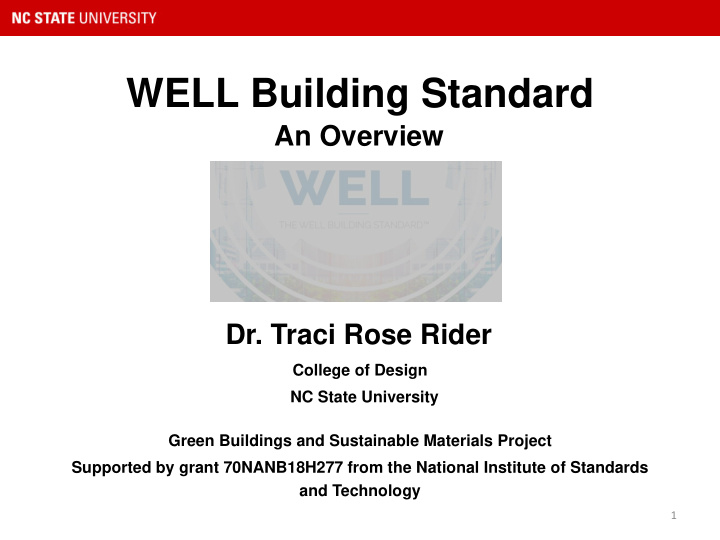



WELL Building Standard An Overview Dr. Traci Rose Rider College of Design NC State University Green Buildings and Sustainable Materials Project Supported by grant 70NANB18H277 from the National Institute of Standards and Technology 1
“Better buildings to help people thrive” • WELL was launched in October 2014 after six years of research and development • International WELL Building Institute • Focused on improving occupant health • Designed to work with green building standards • Integrates evidence-based research from fields of: – Environmental health – Behavioral factors – Health outcomes Image by Gerd Altmann from Pixabay – Demographic risk factors • Expert peer review from Scientific, Practitioner, and Medical fields. • WELL v1 (2014) and WELL v2 (2018) 2
IWBI/ WELL Mission: • Know how to create spaces that enhance, rather than hinder health and well-being. • Measure and subsequently improve the quality of our air , water and light . • Know how to design environments that fuel our bodies, keep us moving, inspire our best work and facilitate a Image by rawpixel from Pixabay good night's sleep. “Through the vehicle of WELL, IWBI helps to translate what we know into what we practice.” https://v2.wellcertified.com/v/en/overview 3
Principles of WELL v2 • Equitable • Global • Evidence-based • Technically robust • Customer-focused • Resilient Image by Gerd Altmann from Pixabay https://v2.wellcertified.com/v/en/overview 4
WELL Scoring and Certification Levels • WELL Silver Certification: 50 points • WELL Gold Certification: 60 points • WELL Platinum Certification: 80 points Image from the WELL Building Standard v1 with 2017 Q4 addenda 5
Concepts and Features 6
Air • Fundamental Air Quality (P) • Smoke-Free Environment (P) • Ventilation Effectiveness (P) • Construction pollution management (P) • Enhanced Air Quality • Enhanced Ventilation • Operable Windows • Air Quality Monitoring and Awareness • Pollution Infiltration Management • Combustion Minimization • Source Separation • Air Filtration • Active VOC Control • Microbe and Mold Control https://v2.wellcertified.com/v2.1/en/concepts 7
Water • Fundamental water quality (P) • Water contaminants (P) • Legionella Control (P) • Enhanced Water Quality • Water Quality Consistency • Drinking Water Promotion • Moisture Management • Handwashing Image by Gerd Altmann from Pixabay https://v2.wellcertified.com/v2.1/en/concepts 8
Nourishment • Fruits and Vegetables (P) • Nutritional Transparency (P) • Refined Ingredients • Food Advertising • Artificial Ingredients • Portion Sizes • Nutritional Education • Mindful Eating • Special Diets Image by silviarita from Pixabay • Food Preparation • Responsible Food Sourcing • Food Production • Local Food Environment https://v2.wellcertified.com/v2.1/en/concepts 9
Light • Light Exposure and Education (P) • Visual Lighting Design (P) • Circadian Lighting Design • Glare Control • Enhanced Daylight Access • Visual Balance • Electric Light Quality • Occupant Control of Lighting Environments Image by StockSnap from Pixabay https://v2.wellcertified.com/v2.1/en/concepts 10
Movement • Active Building and Communities (P) • Visual and Physical Ergonomics (P) • Movement Network and Circulation • Active Commuter and Occupant Support • Site Planning and Selection • Physical Activity Opportunities • Active Furnishings • Physical Activity Spaces and Image by Steve Buissinne from Pixabay Equipment • Exterior Active Design • Enhanced Ergonomics • Physical Activity Promotion • Self-Monitoring https://v2.wellcertified.com/v2.1/en/concepts 11
Thermal Comfort • Thermal Performance (P) • Enhanced Thermal Performance • Thermal Zoning • Individual Thermal Control • Radiant Thermal Control • Thermal Comfort Monitoring • Humidity Control Image by Paul Tate from Pixabay https://v2.wellcertified.com/v2.1/en/concepts 12
Sound • Sound Mapping • Maximum Noise Levels • Sound Barriers • Sound Absorption • Sound Masking Image by Gordon Johnson from Pixabay https://v2.wellcertified.com/v2.1/en/concepts 13
Materials • Fundamental Materials Precautions (P) • Hazardous Material Abatement (P) • Outdoor Structures (P) • Waste Management • In-Place Management • Site Remediation • Pesticide Use • Hazardous Material Reduction • Cleaning Products and Protocols • Volatile Compound Reduction Image by succo from Pixabay • Long-Term Emission Control • Short-Term Emission Control • Enhanced Material Precaution • Material Transparency https://v2.wellcertified.com/v2.1/en/concepts 14
Mind • Mental Health Promotion (P) • Access to Nature (P) • Mental Health Support • Mental Health Education • Stress Support • Restorative Opportunities • Restorative Spaces • Restorative Programming • Enhanced Access to Nature • Focus Support • Sleep Support • Image by teeveesee from Pixabay Business Travel • Tobacco Prevention and Cessation • Substance Use Education and Services • Opioid Emergency Response Plan https://v2.wellcertified.com/v2.1/en/concepts 15
Community • Health and Wellness Awareness (P) • Integrative Design (P) • Occupant Surveys (P) • Enhanced Occupant Survey • Health Services and Benefits • Health Promotion • Community Immunity • New Parent Support • New Mother Support • Family Support • Civic Engagement • Organizational Transparency Image by rawpixel from Pixabay • Accessibility and Universal Design • Bathroom Accommodations • Emergency Preparedness • Community Access and Engagement https://v2.wellcertified.com/v2.1/en/concepts 16
Innovation • Innovate WELL • WELL Accredited Professional (WELL AP) • Educate WELL • Gateways to Wellness • Green Building Rating Systems Image by Michael Jarmoluk from Pixabay https://v2.wellcertified.com/v2.1/en/concepts 17
WELL Standard Website https://www.wellcertified.com 18
Visit Our Project Website https://faculty.cnr.ncsu.edu/yuanyao/green-buildings-and-sustainable-materials/ This presentation and video were prepared by the project team (Yuan Yao, Stephen Kelley, Traci Rider, and Adam Scouse) at North Carolina State University using Federal funds under award 70NANB18H277 from the National Institute of Standards and Technology, U.S. Department of Commerce. The statements, findings, conclusions, and recommendations are those of the author(s) and do not necessarily reflect the views of the National Institute of Standards and Technology or the U.S. Department of Commerce. 19
Recommend
More recommend